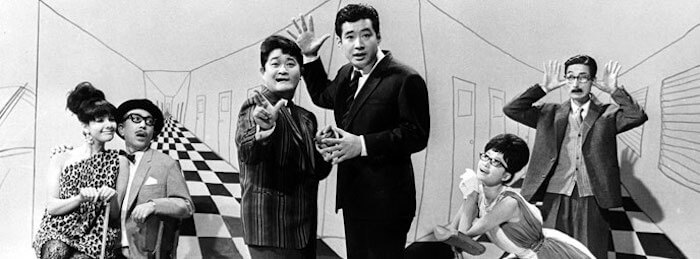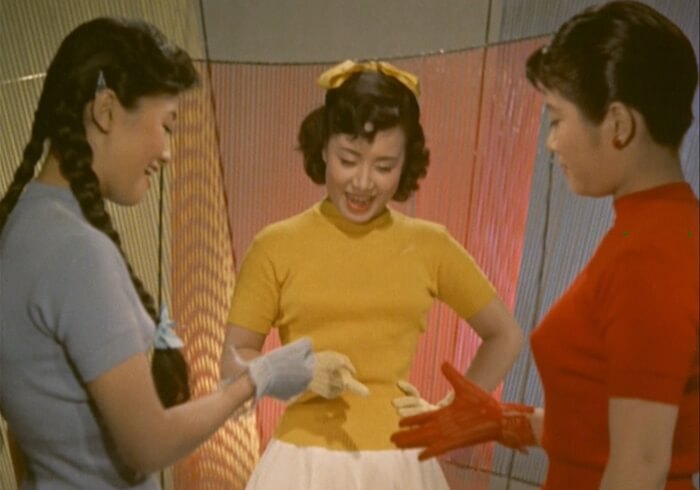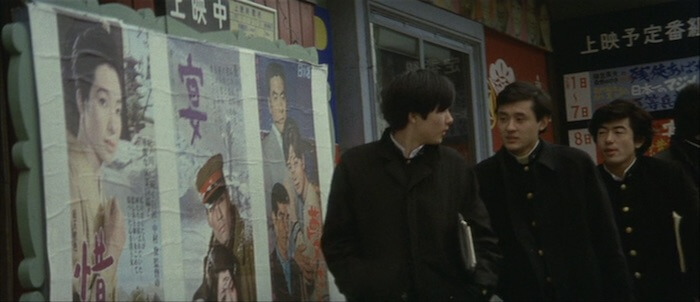A Society Out of Tune? Japan Society’s “Japan Sings!” Surveys a Century of Musicals


April 8-23 at the Japan Society
The Japan Society’s all-35mm “Japan Sings!” offers ten diverse feature-length examples of musicals drawn from throughout Japanese film history. The selection (which was curated by Michael Raine, a Japanese film scholar and film studies instructor at Western University, Canada) moves between comedy and tragedy as well as across period and contemporary settings filled with an array of operetta tunes, colloquial ballads, jazz pieces, and pop.
The opening night film is 1964’s TohoScope-shot, Broadway-inspired You Can Succeed, Too (directed by Eizo Sugawa), in which Tokyo’s upcoming Olympics gives occasion for tourism companies to scheme over how to score foreign clientele. The upright adult daughter (played by Izumi Yukimura) of a company boss lectures employees in epic song-and-dance fashion about the lessons she learned on efficiency, professionalism, and good comportment from her time spent in America. The young fellow in her sight that gets furthest ahead, though, is a skinny one (Tadao Takashima) who succeeds simply by being helpful to others. In staying true to himself, he earns both dollars and the woman’s heart.
In You Can Succeed, Too, the characters learn to win foreign money while still maintaining sentimental ideals. The film is one of the popular “salaryman” films that flourished in Japan in the 1950s and 1960s (with 1962’s Irresponsible Era of Japan, screening April 16th, being another, and 1964’s Oh, Bomb! offering a kind of spoof on the subgenre with a yakuza spin). Many surface resemblances exist between these films and contemporaneous office comedies from the United States, a nation whose military had occupied Japan for seven years following the Second World War. Among the most intriguing aspects of several “Japan Sings!” films involves the ways in which characters negotiate postwar identities and incorporate foreign influences while seeking to reestablish themselves as individuals.


The Japanese film industry began producing musicals long prior to World War II—in fact, as early on as the silent era, in the form of silent films featuring benshis (storytellers) who would sing during projections. The earliest film in “Japan Sings!”, though, is an early sound film, Masahiro Makino’s 1939 hybrid of operetta and jazz called Singing Lovebirds (screening April 12th). This period film shot by the great cinematographer Kazuo Miyagawa follows a young woman named Oharu (Haruyo Ichikawa) and four of her male suitors over several gracefully rolling shots throughout their village. Oharu’s father (Takashi Shimura) is a samurai-turned-umbrella salesman faced with the prospect of having to sell Oharu off to a lord in order to pay a debt, a problem exacerbated by Oharu’s lasting attraction to a young ronin (Chieko Kataoka) contemptuous of financial gain. Oharu and the people with whom she falls deepest in sympathy work together to please each other, and keep each others’ spirits up by turning even fatalistic sentiments into songs. The film stays cheery in spite of its characters’ circumstances, and ultimately posits love as offering a greater happiness than any material wealth can.


The best-known auteur in “Japan Sings!”, Nagisa Oshima, was once called a samurai by a fellow filmmaker. Oshima’s 1967 musical A Treatise on Japanese Bawdy Songs (aka Sing a Song of Sex, screening April 19th) is the work of one in league with his society’s disempowered members. The film’s action unfolds on Japan’s much-disputed National Foundation Day (commemorating the accession of the nation’s first Emperor) and follows several high school students from the nearby provincial city of Maebashi who have traveled to Tokyo to take university entrance exams. The young men prefer to think about sex over academic studies, a line of thought encouraged by a drunken leftist former teacher (Juzo Itami) who leads them and young women in traditional bawdy songs post-examinations under the logic that obscenities represent the voices of the oppressed. The boys continue to sing these songs well after their professor’s death, while a young Korean woman in their midst (Hideko Yoshida) surprisingly picks up a piercing traditional prostitute’s call. Her haunting words meet with the males’ raucous ones, forcing a lingering doubt over which traditions are worth study.
“Japan Sings!” jumps more than thirty years ahead after Oshima’s film, concluding with a double-bill of more recent works on April 23rd. Takashi Miike’s 2001 horror comedy The Happiness of the Katakuris presents a family running a country inn whose infrequent guests consistently die on the premises, leading the caretakers to dispose of bodies with increasing panic as they wonder if their fortunes can change. Tetsuya Nakashima’s 2006 character study Memories of Matsuko begins with a young man (Eita) investigating the murder of his pariah aunt (Miki Nakatani) and eventually leads into a colliding succession of scenes from the dead woman’s life that show her acts of self-sacrifice for others leading over and over to rejection and loss. Both films are often ugly by design, and at many points, profoundly moving. When the lead characters open up their mouths to sing, they do so in order to release cries of pain, and then—if they are lucky—to replace their pain with hope.
Thanks go to series curator Michael Raine for research help with this piece.
You might also like 




















